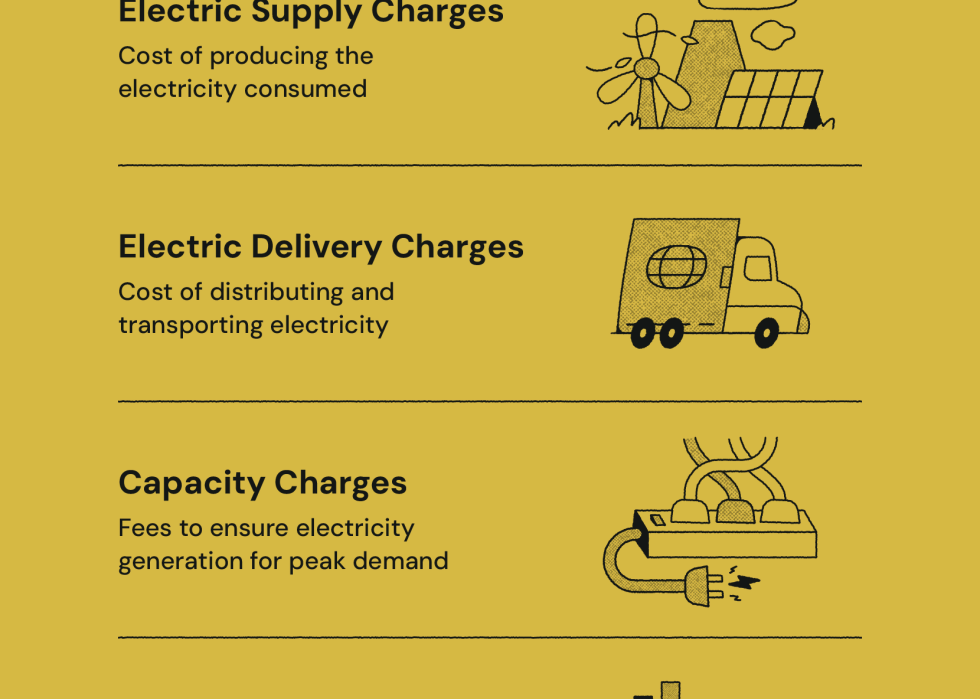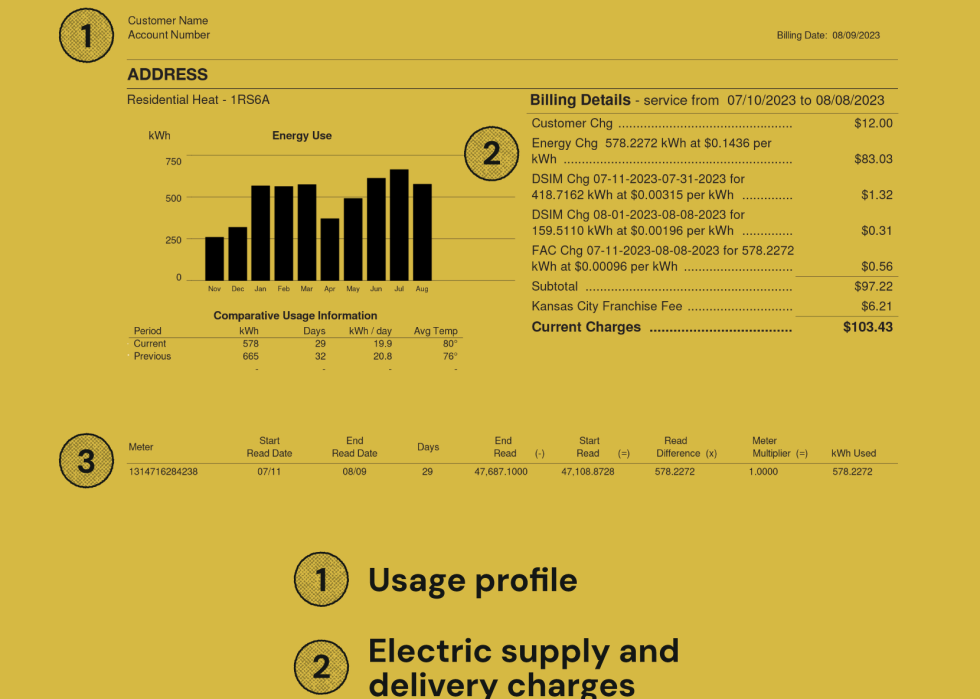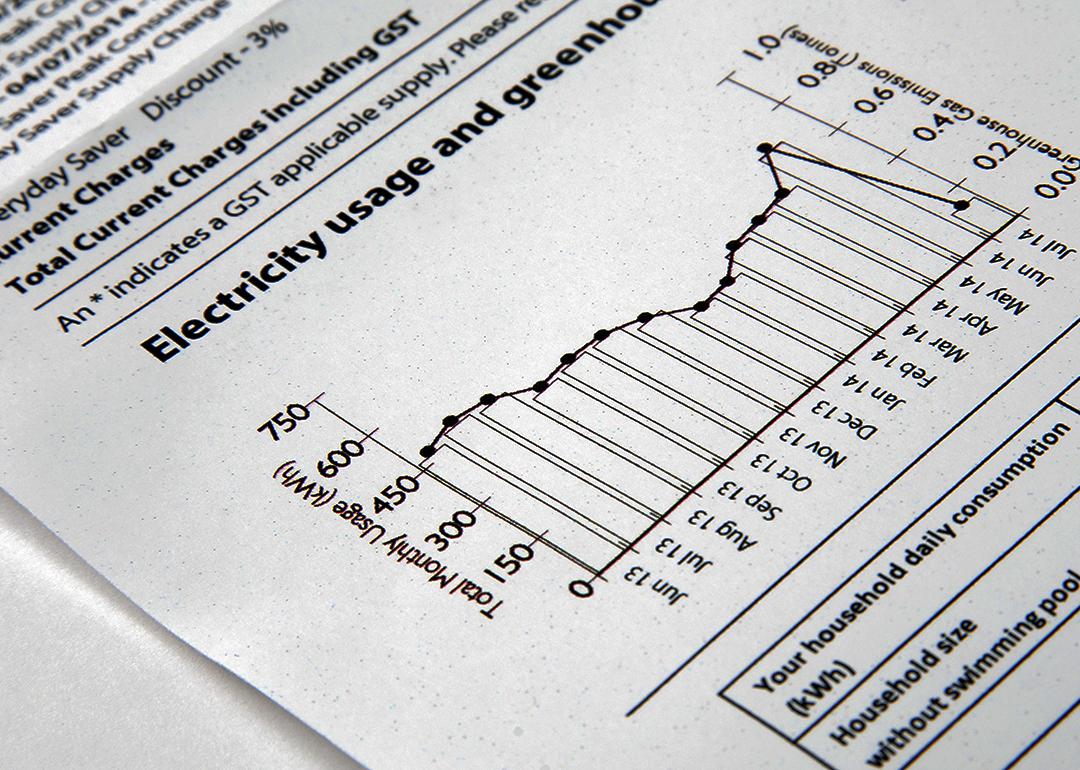How to read an electric bill: Electric bill breakdown

To help you get a better understanding of your electric bill breakdown, here's what you can find included in your power bill.
Meter reading
Your meter reading, also known as electricity cost, is the most fundamental charge on your electric bill. It represents the cost of the electricity you've consumed during the billing period and is typically measured in kilowatt-hours, or kWh. The rate you're charged per kWh is determined by your utility provider or your chosen rate plan.
Electric supply charges
Your electric supply charges cover the cost of generating or purchasing electricity from power plants. It includes the cost of producing the electricity you consume. This part of the bill is typically based on the rate per kWh.
Electric delivery charges
Electric delivery charges encompass several components, including:
- Customer charges: A fixed monthly fee for being connected to the electric grid and having access to electricity.
- Transmission charges: Cover the cost of transmitting electricity over long distances from power plants to local distribution networks.
- Distribution charges: The cost of delivering electricity from the local distribution network to your home or business.
- Transition charges: Charges that may relate to transitioning to cleaner or renewable energy sources and are intended to support environmental initiatives.
- Public policy charges: Fees that fund government programs or policies related to energy efficiency, low-income assistance, or other public purposes.
Capacity charges
Some bills may include capacity charges, or fees associated with ensuring there is enough electricity generation capacity available to meet peak demand. These charges essentially serve as insurance against potential power outages, which can occur when there's high electricity usage.
Usage profile
This section of the bill provides information about your account and historical electricity usage patterns. Here are a few things you may see on your usage profile:
- Your name and address
- Account number
- Your energy company's name
- The past 12 months of usage history
- Comparative usage information from the previous period
- Your billing cycle's start and end dates
This information may also be presented in charts or graphs showing your monthly or annual consumption, which can be useful for understanding your usage trends. You can use this section to help you track your monthly consumption.
Other utilities
While an electric bill mainly focuses on electricity charges, it may also include information about other utility services if your utility provider offers them. These services could include:
- Natural gas charges: If your gas service is provided by the same utility company, any natural gas charges may be included on the same bill.
- Water charges: In some cases, water charges may also be included if the same utility company provides both water and electricity services.

To help you get a better idea of what to expect on an electric bill, here's a real-life example.
Understanding your energy costs
To fully understand your energy costs, you'll need to know what a kWh is and how your electricity cost is calculated.
What Is a kWh?
A kilowatt-hour, or kWh, is a unit of measurement for electricity consumption. It represents the amount of energy consumed when a device with a power rating of one kilowatt (1 kW) operates continuously for one hour. It's essentially a measure of how much electricity you use over time.
For example, if you have a 100-watt light bulb turned on for 10 hours, it would consume 1 kWh of electricity (100 watts x 10 hours = 1,000 watt-hours, or 1 kWh).
How do you calculate electricity cost?
To calculate your electricity cost, you need to consider the following factors:
- Electricity rate (price per kWh): This is the cost you pay for each kilowatt-hour of electricity you consume. It's typically provided by your utility provider and can vary depending on your location, rate plan, and usage.
- Electricity usage (in kWh): This is the total amount of electricity you've consumed during a specific period, usually measured in kilowatt-hours.
To calculate your electricity cost, use the following formula:
Electricity rate (dollars per kWh) x electricity usage (in kWh) = electricity cost
Here's a step-by-step example of how to calculate your electricity cost:
- Find your electricity rate on your electric bill. For example, the average kWh price in the U.S. is $0.17 per kWh.
- Determine your electricity usage for the billing period. For instance, the average American consumes 886 kWh in one month.
- Use the formula to calculate your electricity cost: $0.17 per kWh x 886 kWh = $150.62
So, in this example, your electricity cost for the month would be $150.62.
Understanding your electricity cost allows you to track your energy expenses, budget more effectively, and identify opportunities to reduce consumption and save money. It's essential to monitor your usage and know your electricity rate to manage your energy costs efficiently.
What runs your electric bill up the most?
Several factors can impact your electric bill, and understanding them can help you identify what's contributing the most to your energy costs. Here are some factors that can run up your electric bill:
- Energy types: The type of energy sources used in your area can have a major influence on your bill. Regions with higher reliance on fossil fuels may have higher electricity costs compared to areas with a greater share of renewable energy sources. The energy mix in your region can affect the rate you pay for electricity.
- Rate structures: Your choice of rate structure, whether fixed, variable, or budget billing, plays a significant role in your bill. Variable and time-of-use rates can result in higher bills during peak periods when electricity rates are higher.
- Air control systems: Heating, ventilation, and air conditioning (HVAC) systems are among the biggest energy consumers in homes and businesses. Running these climate control systems inefficiently or keeping them on unnecessarily can drive up your bill.
- Weather: Extreme temperatures can cause spikes in energy consumption since heating and cooling systems run more frequently.
- Building insulation: Insufficient insulation or drafty windows and doors can lead to heat loss in the winter and heat gain in the summer, which makes your heating or cooling systems run more often.
- Technology use: Modern households and businesses often have numerous electronic devices that draw power continuously.
- Occupants: More occupants in a building mean increased demand for lighting, heating, cooling, and hot water.
